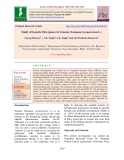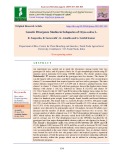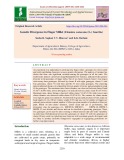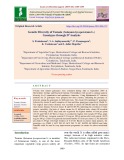
Intra and inter cluster distance
-
Genetic diversity among sixty three okra genotypes was estimated using Mahalanobis D2 statistic. The genotypes were grouped into nine clusters. The maximum number of genotypes was found in cluster I (36) followed by cluster III (15) and Cluster II (6). Remaining all were solitary clusters with single genotype.
 6p
6p  gaocaolon9
gaocaolon9
 22-12-2020
22-12-2020
 17
17
 2
2
 Download
Download
-
Soybean [Glycine max (L.) Merrill] is a major oil seed crop having 20% oil and 38 to 43% protein which has biological value as meat and fish protein. A field experiment was conducted during Kharif 2013 at Agriculture Research Station (ARS), Kota Agriculture University, Kota (Rajasthan) to study the genetic divergence in 24 soybean genotypes and observations on 9 traits of were recorded.
 11p
11p  chauchaungayxua8
chauchaungayxua8
 03-10-2020
03-10-2020
 9
9
 1
1
 Download
Download
-
The present study was undertaken with the aim of examining the magnitude of genetic diversity and characters contributing to genetic diversity among brinjal genotypes for a planned breeding programme.
 7p
7p  trinhthamhodang1215
trinhthamhodang1215
 23-09-2020
23-09-2020
 7
7
 1
1
 Download
Download
-
The present study was carried out to assessment of genetic diversity and screening of sheath blight at the Research Farm of Department of Genetics and Plant Breeding, N.D. University of Agriculture & Technology, Narendra Nagar (Kumarganj), Faizabad. Results revealed that 22 genotypes were grouped into five different non-overlapping clusters. Cluster V, having 6 genotypes, emerged with highest number of entries. The maximum intra-cluster distance was found for cluster II (325.16) and highest inter-cluster distance was recorded between cluster IV and V (32140.59).
 7p
7p  chauchaungayxua6
chauchaungayxua6
 26-06-2020
26-06-2020
 15
15
 1
1
 Download
Download
-
Genetic diversity study involving twenty one thermo tolerant tomato genotypes was carried out for twelve physiological and biochemical characters at Indian Agricultural Research Institute, New Delhi during summer season of the year 2014. All the genotypes were grouped into 4 distinct clusters using D2 statistics. Cluster I and cluster II comprised of 10 genotypes represented by heat tolerant genotypes while cluster III showed 4 heat sensitive genotypes. The clustering analysis of all genotypes showed that heat sensitive and heat tolerant genotypes were represented by distinct clusters.
 9p
9p  nguaconbaynhay6
nguaconbaynhay6
 24-06-2020
24-06-2020
 12
12
 0
0
 Download
Download
-
To study the genetic divergence of chilli, 48 genotypes were evaluated in Randomized Block Design with two replications at the experimental field of College of Horticulture Bagalkot. The genetic material exhibited wide range of genetic divergence for all the 20 characters investigated. The cluster I constituted maximum number (20) of genotypes, cluster II had 5 genotypes cluster- III, IV and V with 7 genotypes, cluster VI and cluster VII had only one genotype each. Cluster-VI and cluster-V showed maximum inter cluster distance whereas the distance between clusters IV and II was least.
 6p
6p  angicungduoc5
angicungduoc5
 14-06-2020
14-06-2020
 9
9
 0
0
 Download
Download
-
Studies were carried out to assess the genetic divergence among 14 ridge gourd genotypes using mahalanobis D2 . For genetic divergence fourteen varieties were grouped into four clusters.
 5p
5p  cothumenhmong5
cothumenhmong5
 17-05-2020
17-05-2020
 12
12
 1
1
 Download
Download
-
A field experiment was conducted to examine the genetic divergence among 64 Black gram genotypes at Research and Education Farm, Department of Agriculture Botany, College of Agriculture, Dapoli, Dist. Ratnagiri during rabi2017-18.Sixty four genotypes weregroupedinto9 different clusters on the basis of magnitude of D2 values evaluated by Mahalanobis D2 analysis. Among sixty four genotypes, 16 genotypes were clustered in to fourth and fifth cluster followed by cluster I having 13 genotypes. The cluster II included 10 genotypes, while cluster III had 5 genotypes.
 8p
8p  cothumenhmong5
cothumenhmong5
 17-05-2020
17-05-2020
 15
15
 2
2
 Download
Download
-
Twenty five diverse genotypes of brinjal (Ten hybrids and fifteen open pollinated varieties) were evaluated for 20 different quantitative, qualitative and biotic stress traits in the experimental field of Division of Vegetable Science & Floriculture, FOA, Chatha, SKUAST, Jammu during 2013-14 and 2014-15.
 7p
7p  chauchaungayxua5
chauchaungayxua5
 08-05-2020
08-05-2020
 15
15
 1
1
 Download
Download
-
Fifty-six diverse genotypes of cucumber collected from different indigenous sources were planted in randomized block design, during kharif season at Kittur Rani Chennamma College of Horticulture, Arabhavi, Belagavi district (Karnataka), India. Genetic diversity study using Mahalanobis’s D2 statistics with Tocher’s method, 56 cucumber genotypes were grouped into ten clusters, cluster I was the largest having 26 genotypes followed by cluster III (10 genotypes) followed by cluster II (six genotypes).
 9p
9p  angicungduoc4
angicungduoc4
 04-05-2020
04-05-2020
 32
32
 0
0
 Download
Download
-
Thirty diverse genotypes of cucumber collected from different indigenous and exotic sources were planted in randomized complete block design, during kharif season of 2016 and were assessed to know the nature and magnitude of genetic divergence for different horticultural traits, using Mahalanobis D2 statistics. All the characters under study showed considerable divergence and the genotypes were grouped into five clusters. Cluster II contained the maximum (12) number of genotypes, whereas cluster V contained minimum (3) genotypes. The intra cluster distance was maximum in cluster IV (3.
 9p
9p  kethamoi4
kethamoi4
 16-04-2020
16-04-2020
 12
12
 1
1
 Download
Download
-
Study on Genetic Diversity was conducted with 16 chilli (Capsicum annuum L.) genotypes at the field of Vegetable Research Block of V.C.S.G. Uttarakhand University of Horticulture and Forestry, Ranichauri Campus Tehri- Garhwal during Kharif2014. Genetic diversity among 16 chilli genotype was worked out usingD2 statistic. On the basis of genetic distance, these genotypes were grouped into 5 clusters. Cluster I was largest, consisting of nine genotypes followed by cluster II with four genotypes while cluster III, IV and V contained single genotype each.
 6p
6p  quenchua4
quenchua4
 06-04-2020
06-04-2020
 11
11
 1
1
 Download
Download
-
A B S T R A C T Introduction Chickpea (Cicer arietinum L.) is the 3rd largest produced food legume in the world after common bean and field pea and is widely grown in the semi-arid regions (Gaur et al., 2012). It is important pulse crop in India and contributing about~70% of the global chickpea production (FAOSTAT, 2012). It has excellent nutrition value in terms of human dietary protein. In addition to having high protein content (20-22%) (McIntosh and Topping 2000; Charles et al., 2002).
 8p
8p  caygaocaolon4
caygaocaolon4
 04-04-2020
04-04-2020
 24
24
 0
0
 Download
Download
-
Genetic divergence among 30 eggplant (Solanum melongena L.) genotypes was estimated using Mahalanobis D2 Statistics. The 30 genotypes were grouped into six distinct clusters. Among the different clusters, cluster III consisted maximum number of genotypes (8 genotypes) followed by cluster I and VI (5 genotypes), cluster II, IV and V contained (4 genotypes). The highest intra-cluster distance was recorded for cluster I (1250.024) followed by cluster II (1217.052) and the lowest intra-cluster distance was recorded for cluster-V (389.277).
 9p
9p  trinhthamhodang4
trinhthamhodang4
 22-03-2020
22-03-2020
 10
10
 2
2
 Download
Download
-
Genetic divergence of 30 okra genotypes was studied using Mahalanobis D2 statistics revealed that considerable genetic diversity among genotypes in okra. Thirty diverse genotypes were grouped into six clusters with the highest of 11 genotypes in the cluster II, 10 in the cluster I, 4 genotypes in the cluster III, 3 in cluster V and 1 in each IV and VI cluster. The inter cluster distance was higher than the intra cluster distance indicating wide genetic diversity among the genotypes of different groups.
 9p
9p  trinhthamhodang4
trinhthamhodang4
 22-03-2020
22-03-2020
 16
16
 2
2
 Download
Download
-
Sixty ashwagandha germplasm and 3 checks were evaluated to study the diversity pattern among the collected accession. The genotypes were grouped into eight clusters. The cluster VII had highest number of genotypes (18) followed by (10) in cluster III. The inter-cluster distance was higher than intra cluster distance indicating wide genetic diversity among the genotypes.
 6p
6p  chauchaungayxua4
chauchaungayxua4
 18-03-2020
18-03-2020
 11
11
 1
1
 Download
Download
-
Present investigation was carried out at Vegetable Research Farm, RPCAU, Pusa, Samastipur, Bihar during 2018-19 (Rabi). About thirty genotypes were evaluated for 15 growth, yield and quality characters which were grouped into six clusters. Cluster I topped in having maximum of ten genotypes followed by cluster IV and V with seven genotypes each, cluster II with four genotypes, while cluster III and VI were monotypic (one genotype each). The maximum intra cluster distance was observed in cluster IV (550.48) followed by clusters IV (490.54), cluster II (397.02) and cluster I (379.
 8p
8p  caygaocaolon3
caygaocaolon3
 27-02-2020
27-02-2020
 24
24
 1
1
 Download
Download
-
An experiment was carried out to study the divergence among twenty four rice genotypes (14 indica and 10 japonica lines) for 15 agro-morphological traits using D2 statistics and at molecular level using 114SSR markers. The cluster analysis using Mahalonobis’ D2 statistics classified the genotypes into five clusters. The cluster IV was the largest with seven indica and three tropical japonica types. The second largest cluster (V) accommodated four tropical japonica and two indica genotypes. The intra cluster distance ranged from 1.077 to 8.
 12p
12p  trinhthamhodang3
trinhthamhodang3
 12-02-2020
12-02-2020
 20
20
 0
0
 Download
Download
-
An experiment was undertaken by utilizing forty finger millet genotypes for eleven yield and yield contributing characters to assess genetic divergence. The analysis of variance has shown that there was significant variation among the genotypes in all the traits. The multivariate analysis carried out using Mahalanobis D2-statistics, indicated wider genetic diversity in the genotypes of finger millet.
 13p
13p  chauchaungayxua3
chauchaungayxua3
 07-02-2020
07-02-2020
 14
14
 1
1
 Download
Download
-
Twenty four tomato genotypes were evaluated during June to September 2018 at Horticulture College and Research Institute, Periyakulam with an aid to estimate genetic diversity for 15 quantitative and qualitative characters. Using Mahalanobis D2 statistics method, the 24 genotypes were grouped into three clusters, indicating the presence of diversity among the genotypes for different traits. The cluster III containing 17 genotypes followed by cluster II and I comprises of four and three genotypes respectively (Table 5). The highest intra-cluster distance was recorded in cluster III (60.
 7p
7p  chauchaungayxua3
chauchaungayxua3
 07-02-2020
07-02-2020
 17
17
 0
0
 Download
Download
CHỦ ĐỀ BẠN MUỐN TÌM









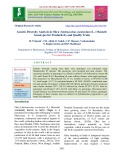
![Morphological characterization and assessment of genetic diversity in soybean [Glycine max (L.) Merrill] genotypes Morphological characterization and assessment of genetic diversity in soybean [Glycine max (L.) Merrill] genotypes](https://tailieu.vn/image/document/thumbnail/2020/20201003/chauchaungayxua8/135x160/5061601687552.jpg)
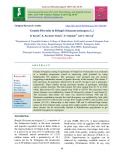
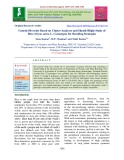
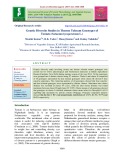
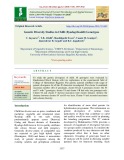
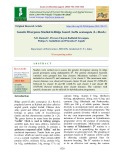
![Evaluation of genetic divergence in black gram [Vigna mungo (L.) Hepper] Evaluation of genetic divergence in black gram [Vigna mungo (L.) Hepper]](https://tailieu.vn/image/document/thumbnail/2020/20200517/cothumenhmong5/135x160/9311589726717.jpg)
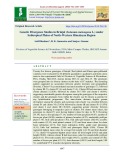
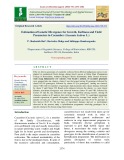
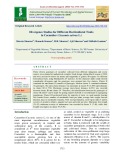

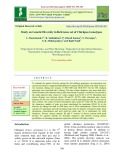
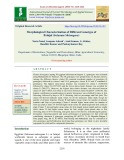
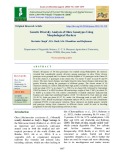
![Assessment of genetic divergence in Ashwaganda [Withania somnifera (L.) Dunal] Assessment of genetic divergence in Ashwaganda [Withania somnifera (L.) Dunal]](https://tailieu.vn/image/document/thumbnail/2020/20200318/chauchaungayxua4/135x160/7091584549783.jpg)
